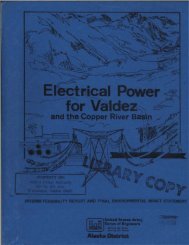Before the FERC Application for New License for the Annex Creek ...
Before the FERC Application for New License for the Annex Creek ...
Before the FERC Application for New License for the Annex Creek ...
You also want an ePaper? Increase the reach of your titles
YUMPU automatically turns print PDFs into web optimized ePapers that Google loves.
E-5<br />
Project 11 cense, because of safety cons i derations. (See Dam Safety Report,<br />
included in <strong>the</strong> Supporting Design Documentation to Exhibit F.) Water from <strong>the</strong><br />
Salmon <strong>Creek</strong> Dam is conveyed downstream to <strong>the</strong> Upper Powerhouse via <strong>the</strong><br />
4,475-foot-long steel Upper Penstock. <strong>Be<strong>for</strong>e</strong> reaching <strong>the</strong> powerhouse, however,<br />
<strong>the</strong> penstock bi furcates perm; tti ng water to be di verted to <strong>the</strong> Upper<br />
Powerhouse (2.8 MW) or to <strong>the</strong> 11,030-foot-long Lower Penstock which leads to<br />
<strong>the</strong> Lower Powerhouse (6.7 MW). The flow is controlled by two butterfly<br />
va 1 ves. Because <strong>the</strong> same penstock serves both powerhouses, <strong>the</strong>y cannot be<br />
operated simultaneously. The Upper Powerhouse contains two 2,500-horsepower<br />
i mpul se turbi nes connected to 2, 300-Vo 1 t generators. The Lower Powerhouse<br />
contains one 9,210-horsepower impulse turbine connected to a 12,700-Volt generator.<br />
An arbitrary elevation datum was used <strong>for</strong> <strong>the</strong> Salmon <strong>Creek</strong> Dam and<br />
Upper Powerhouse when <strong>the</strong>y were constructed. This arbitary datum is<br />
26.29 feet below Mean Lower Low Hater (MLLW) and fixes <strong>the</strong> dam spillway crest<br />
at El 1172. Throughout this exhibit this datum will be referred to as <strong>the</strong><br />
Upper Salmon <strong>Creek</strong> Datum (USCD).<br />
The Lower Penstock and Lower Powerhouse used an elevation datum<br />
4.79 feet below MLLW. This arbitrary datum w1l1 be referred to as <strong>the</strong> Lower<br />
Salmon <strong>Creek</strong> Datum (LSCD).<br />
1 • 3 • 2 C 1 i rna t e<br />
Typical climatic conditions of Sou<strong>the</strong>ast Alaska are discussed in<br />
Section 1.1.2. Temperatures at <strong>the</strong> Salmon <strong>Creek</strong> Component are similar to<br />
those measured in downtown Juneau.<br />
The mean temperature in downtown Juneau ranges from 42°F to<br />
61°F in summer, and 18°F to 34°F in <strong>the</strong> winter. Precipitation data<br />
recorded by Alaska Gastineau Mining Company at <strong>the</strong> Salmon <strong>Creek</strong> Dam and Upper<br />
Powerhouse, and data from nearby Gold and Sheep creeks i nd i cate that annua 1<br />
precipitation at Salmon <strong>Creek</strong> is 100-150 inches, most of which falls during<br />
<strong>the</strong> months of October to December (AELP, 1982>' Total yearly precipitation in<br />
<strong>the</strong> Upper Sa 1 mon <strong>Creek</strong> dra i nage is 15 to 35'1 greater than that in downtown<br />
Juneau, which receives a mean annual precipitation of 91 inches.<br />
Snow occurs frequently in <strong>the</strong> area, but usually melts quickly at<br />
lower elevations. Higher elevations often remain snow covered unti 1 early<br />
summer. The average snowfall in downtown Juneau, based on a 31-year period of<br />
record, is 107 inches.<br />
1.3.3 Topography, Vegetation, and Hetlands<br />
The topographic setting of <strong>the</strong> Salmon <strong>Creek</strong> Reservoir is very<br />
similar to that of <strong>Annex</strong> <strong>Creek</strong>. The Salmon <strong>Creek</strong> drainage basin ranges in<br />
elevation from sea level to 4935 feet at Observation Peak located nor<strong>the</strong>ast of<br />
<strong>the</strong> reservoi r. The hi gher elevations of <strong>the</strong> watershed are character; zed by<br />
exposed bedrock and alpine tundra vegetation, and <strong>the</strong> terrain is precipitous.

















